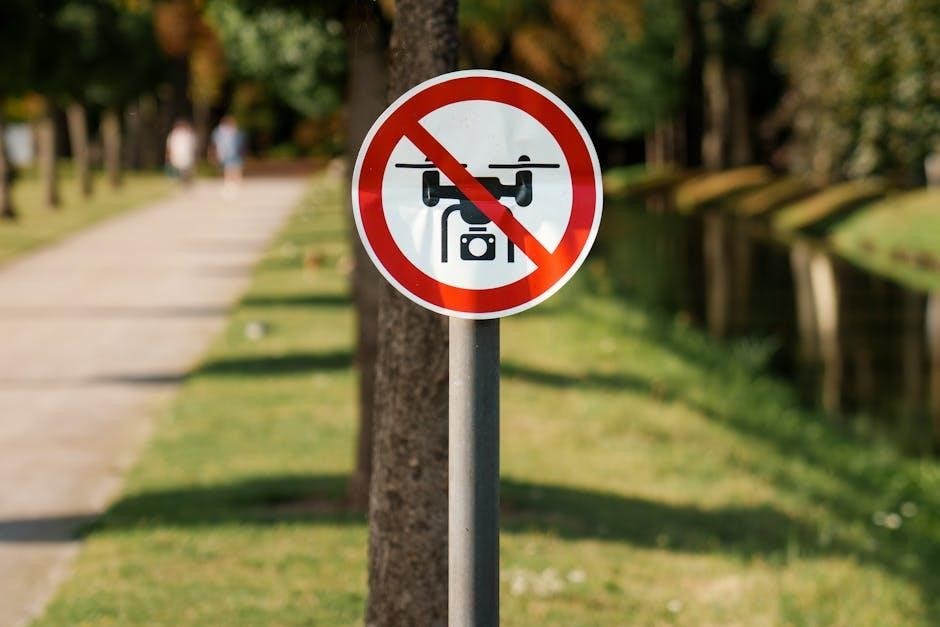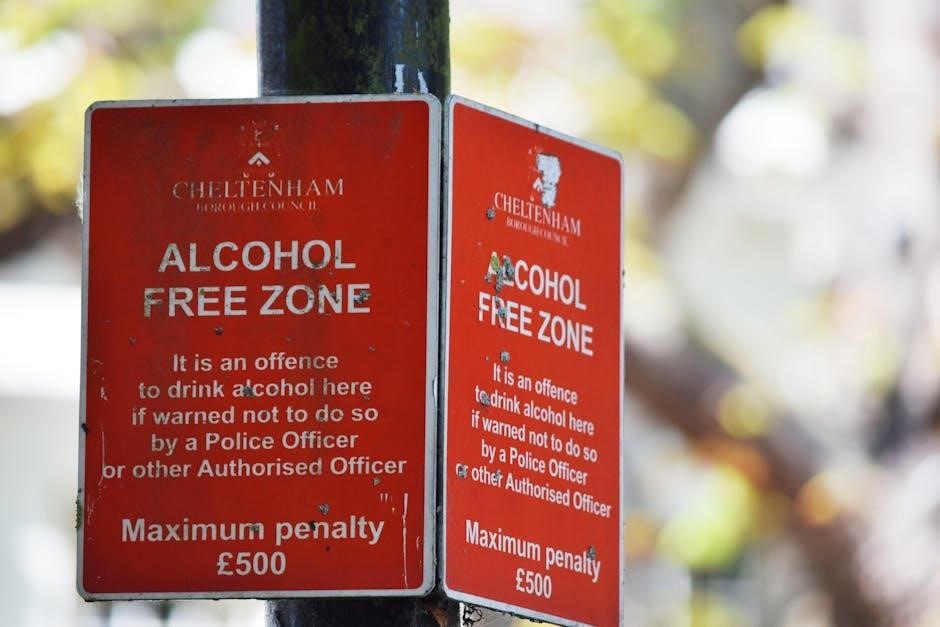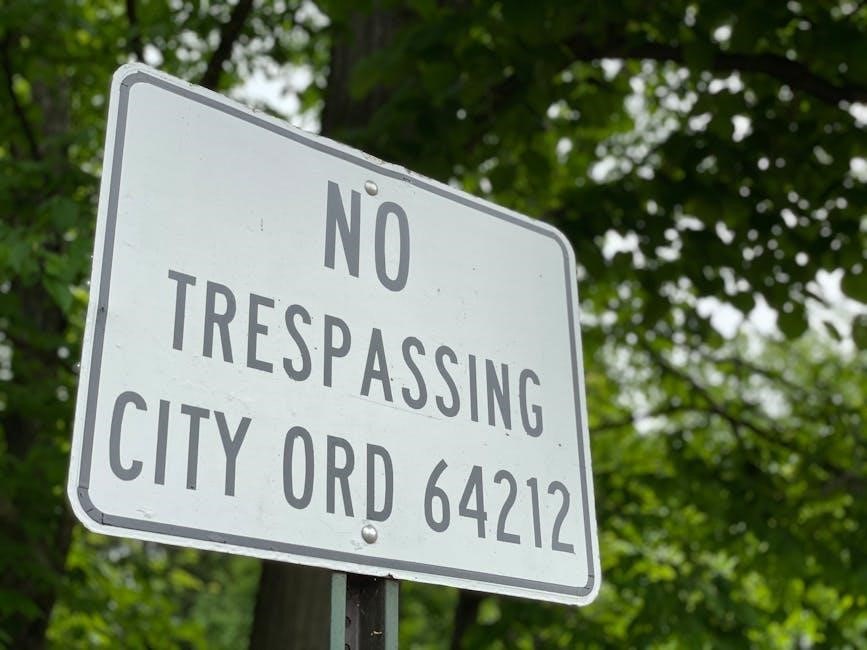Inside Zone Blocking is a fundamental tactic in football, emphasizing offensive linemen blocking specific zones. The “Inside Zone Blocking Rules PDF” outlines key concepts, rules, and strategies for mastering this technique, serving as a valuable resource for coaches and players alike to understand and execute effective blocking schemes.
1.1. What is Inside Zone Blocking?
Inside Zone Blocking is a blocking technique in football where offensive linemen are assigned specific zones to block rather than individual defenders. This strategy focuses on creating seams and lanes for the ball carrier by controlling areas of the defensive front. It requires precise coordination and understanding of assignments, as linemen must adjust their blocks based on defensive alignments and movements. The “Inside Zone Blocking Rules PDF” provides detailed guidelines and visual aids to help players and coaches master this essential blocking scheme effectively.
1.2. Importance of Inside Zone Blocking in Football Strategy
Inside Zone Blocking is a cornerstone of effective rushing attacks, enabling consistent gains by creating predictable lanes. Its flexibility allows adaptation to various defensive schemes, making it a versatile tool for offenses. By controlling the interior, teams can establish a physical presence and dictate the flow of the game. The “Inside Zone Blocking Rules PDF” underscores its strategic value, providing insights into how this blocking scheme enhances overall team performance and contributes to winning strategies on the field, ensuring sustained success in modern football.
1.3; Brief History and Evolution of Zone Blocking
Zone blocking originated in the early days of football, evolving from straightforward power schemes into nuanced strategies. The 1990s saw its rise with coaches like Alex Gibbs refining inside zone techniques. Over time, it adapted to modern defenses, emphasizing quick decisions and lateral movement. The “Inside Zone Blocking Rules PDF” highlights this progression, detailing how the scheme became a cornerstone of offensive strategy, blending tradition with innovation to remain effective in contemporary football, ensuring its enduring relevance and tactical significance.

Key Concepts and Terminology
Inside Zone Blocking involves specific terms like “zone,” “blocking schemes,” and “reads.” It requires understanding offensive line roles, defensive alignments, and blocking rules. Key concepts include lateral movement, double teams, and cut blocks, ensuring cohesion and execution. The “Inside Zone Blocking Rules PDF” details these elements, providing a comprehensive guide for mastering the technique effectively in various game scenarios and strategies.
2.1; Definition of Inside Zone Blocking
Inside Zone Blocking is a football strategy where offensive linemen block specific areas rather than individual defenders. It emphasizes lateral movement, double teams, and cut blocks to create running lanes. The technique requires precise communication and coordination among linemen to seal defenders and allow the ball carrier to exploit gaps. The “Inside Zone Blocking Rules PDF” provides detailed guidelines, ensuring players understand their assignments, blocking angles, and rules for engaging defenders effectively within this scheme.
2.2. Understanding the Role of the Offensive Line
The offensive line plays a crucial role in Inside Zone Blocking, responsible for blocking specific zones rather than individual defenders. Linemen must communicate effectively to identify defensive alignments and adjust their blocking assignments accordingly. Their primary goal is to create seams and seal defenders, allowing the ball carrier to exploit open lanes. The “Inside Zone Blocking Rules PDF” highlights the importance of technique, footwork, and hand placement to ensure legal and effective blocking. Proper execution by the offensive line is essential for the success of the play.
2.3. Key Terminology in Zone Blocking Schemes
Mastering Inside Zone Blocking requires understanding key terminology. Terms like “zone,” “gap,” and “cutoff” define specific blocking areas and techniques. “Reach block” and “double team” describe methods to engage defenders. The “Inside Zone Blocking Rules PDF” outlines these terms, ensuring clarity for players and coaches. Familiarity with this vocabulary is essential for effective communication and execution, enabling the offensive line to block dynamically and create consistent running lanes for the ball carrier.

Rules Governing Inside Zone Blocking
Inside Zone Blocking rules ensure legal techniques, preventing holding or blocking below the waist. Penalties enforce fair play, maintaining safety and competitive balance in execution.
3.1. Basic Rules and Regulations
Inside zone blocking requires linemen to block specific zones rather than individual defenders. Rules mandate hands inside shoulder pads to avoid holding penalties. Blocking below the waist is illegal. Linemen must stay engaged with defenders to maintain blocks legally. Double-team blocks are permitted but must release quickly to avoid penalties. The ball carrier must read blocks and hit designated holes. Proper execution ensures legal play and maximizes offensive effectiveness while maintaining player safety and fair competition.
3.2. Legal and Illegal Block Techniques
In inside zone blocking, legal techniques include hands inside shoulder pads and blocking zones, not individual defenders. Illegal techniques involve holding, chop blocks, or blocking below the waist. Players must avoid grabbing jerseys or using improper contact. Penalties for illegal blocks can disrupt offensive momentum. Understanding these distinctions ensures compliance with rules and enhances player safety. Proper technique execution is crucial for legal, effective blocking and maintaining competitive integrity in the game.
3.3. Penalties Associated with Improper Blocking
Improper blocking in inside zone schemes often results in penalties like holding or illegal block in the back. Holding involves grabbing onto a defender’s jersey or equipment to impede their progress. Illegal blocks above the shoulder pads or below the waist are also penalized. These infractions can lead to a 10-yard penalty, loss of down, or even a first down being overturned. Such penalties disrupt offensive rhythm and can significantly impact field position and scoring opportunities.
Execution and Strategy
Executing inside zone blocks requires precise reading of defenders, coordination between linemen, and synchronization with backfield players to create clear running lanes for the ball carrier.
4.1. Steps for Executing Inside Zone Blocks
- Identify defensive alignment to determine blocking assignments.
- Execute initial contact with hands inside and feet shoulder-width apart.
- Sustain the block by mirroring defender movements.
- Read defensive flow to adjust blocking angles.
- Release to the second level to block linebackers or safeties.
Proper technique and timing ensure effective execution of inside zone blocks.
4.2. Reading Defenders and Adjusting Blocks
Reading defenders is crucial for successful inside zone blocking. Linemen must identify defensive alignment and anticipate movements. They should study defensive tendencies to predict slants or blitzes. Adjustments are made by altering blocking angles or targeting different levels of the defense. Flexibility is key to counter unexpected defensive reactions. Effective communication and quick decision-making ensure seamless adjustments during the play. Properly reading defenders enhances the effectiveness of inside zone blocking schemes.
4.3. Coordination Between Linemen and Backfield
Coordination between linemen and the backfield is vital for inside zone blocking success. Linemen must communicate their blocking assignments clearly to the quarterback and running back. The quarterback’s cadence sets the timing, while the running back reads the blocks to identify the best running lane. Trust and synchronization are essential, as miscommunication can disrupt the play. Proper coordination ensures the offense maximizes gains, making it a cornerstone of effective inside zone execution. Consistent practice strengthens this critical teamwork aspect.

Advantages of Inside Zone Blocking
Inside zone blocking creates consistent running lanes, controls the line of scrimmage, and adapts to various defensive looks, enhancing offensive efficiency and scoring potential significantly.
5.1. Creating Running Lanes for the Ball Carrier
Inside zone blocking is designed to create clear running lanes for the ball carrier by assigning offensive linemen specific areas to block. This approach ensures that the defense is contained, allowing the running back to find open spaces. Through double-team and combo blocks, linemen can open up initial seams. The backfield must read the defense’s flow to identify and explode through these lanes effectively. Proper coordination and execution are crucial for the success of inside zone plays, making them a cornerstone of offenses.
5.2. Flexibility Against Different Defensive Alignments
Inside zone blocking offers versatility by adapting to various defensive alignments. Against odd fronts, linemen focus on controlling the center and guards, while tackles seal the edges. Even fronts require adjustments in blocking angles to create seams. The scheme’s flexibility allows offenses to exploit weaknesses in any defensive setup. By reading pre-snap alignments, linemen can adjust their blocks to ensure consistent running lanes. This adaptability makes inside zone blocking a reliable strategy against diverse defensive looks and pressures.
5.3. Enhancing Team Speed and Agility
Inside zone blocking emphasizes quick footwork and rapid decision-making, enhancing team speed and agility. The scheme’s focus on blocking areas rather than specific defenders allows for faster execution and more explosive plays. Additionally, the running back’s ability to accelerate through openings created by the linemen further boosts the team’s overall agility and effectiveness in the game.

Challenges and Common Mistakes
Mastering inside zone blocking requires precision and coordination, often hindered by defensive adjustments and execution errors, emphasizing the need for consistent practice and mental discipline.
6.1. Common Errors in Inside Zone Blocking
Common errors in inside zone blocking often stem from poor footwork, incorrect aiming points, or failure to read defensive alignments. Linemen may overstep, lunge, or lose balance, compromising blocking integrity. Miscommunication between blockers can lead to gaps, allowing defenders to penetrate. Additionally, neglecting to secure the double-team before climbing to the second level is a frequent mistake. Understanding blocking rules and focusing on technique are crucial to avoiding these errors and ensuring effective execution of the inside zone scheme.

6.2. Overcoming Defensive Counterplays

Defensive counterplays often target inside zone blocking by shifting linemen or blitzing linebackers. To counter, offenses must adjust blocking schemes based on defensive alignments. Pre-snap communication and audible calls are critical to address potential gaps. Linemen should focus on quick footwork and inside hands to secure blocks. Reading defensive movement during the play allows blockers to adjust angles and maintain leverage. Coaches should emphasize studying defensive tendencies to prepare effective counter-strategies, ensuring the offense remains one step ahead of defensive adjustments.
6.3. Maintaining Discipline and Focus
Maintaining discipline and focus is crucial for effective inside zone blocking. Offensive linemen must stick to their assignments, avoiding overcommitment to one gap. Mental discipline ensures proper targeting and blocking angles. Pre-snap communication and adjustments are vital to counter defensive shifts. Consistency in execution reduces penalties and missed blocks. Players must stay focused on their keys, such as defensive movements, to adapt during plays. Film study and practice drills reinforce these habits, ensuring the offense operates smoothly and efficiently in high-pressure situations;

Case Studies and Examples
This section examines real-game scenarios, including NFL and college football examples, to illustrate successful inside zone blocking strategies, historical context, and practical applications of the technique;
7.1. Successful Inside Zone Blocking Plays in NFL Games
Inside zone blocking has been instrumental in NFL teams’ success, particularly in creating explosive running plays. Teams like the Denver Broncos and Kansas City Chiefs have utilized this scheme effectively, enabling star running backs to break tackles and gain significant yards. By adhering to the Inside Zone Blocking Rules PDF, linemen maintain proper angles and timing, ensuring the ball carrier finds open lanes. These strategies have been pivotal in securing victories and highlight the technique’s enduring relevance in modern football.
7.2. Analysis of College Football Zone Blocking Strategies
College football programs frequently employ inside zone blocking to exploit defensive weaknesses. Teams like Alabama and Georgia have mastered this technique, using it to dominate rushing attacks. Coaches emphasize the Inside Zone Blocking Rules PDF to ensure linemen understand assignments and angles. By adapting these strategies, programs create consistent ground games, enabling dynamic playmakers to thrive. This approach has become a cornerstone of collegiate offenses, blending physicality with precision to outmaneuver defenses.
7.3. Historical Significance of Zone Blocking in Football
Zone blocking has evolved significantly, emerging as a strategic response to defensive innovations. It gained prominence alongside offenses like the West Coast system, aiding in controlling the line of scrimmage. The development of the ‘inside zone blocking rules pdf’ formalized its execution, ensuring consistency and legality. Historically, it became crucial for teams like the Denver Broncos, underpinning their success. This strategy is now fundamental in modern football, enabling offenses to create consistent opportunities and adapt to defensive tactics effectively.
How to Learn Inside Zone Blocking
Mastering inside zone blocking requires understanding fundamentals, coordination, and strategy. Start with proper stance, footwork, and hand placement. Utilize drills like ladder and pad work to improve technique and coordination. Study defensive alignments to adjust blocks effectively. Analyze game footage to refine execution and understand strategic integration. Consistent practice and repetition are crucial for developing muscle memory and enhancing performance.
8.1. Coaching Tips for Teaching Zone Blocking
When teaching inside zone blocking, emphasize proper footwork, hand placement, and body positioning. Break drills into smaller parts, focusing on stance, first step, and engagement. Use visual aids like the “Inside Zone Blocking Rules PDF” to reinforce concepts. Encourage linemen to read defenders’ movements and adjust blocks accordingly. Stress the importance of communication and coordination among the offensive line. Incorporate repetition in drills to build muscle memory and consistency. Provide constructive feedback and highlight successful executions to motivate improvement.
8.2. Drills and Practices for Mastering Inside Zone Blocks
Effective drills for mastering inside zone blocks include footwork ladder exercises to improve agility and quick steps. Pad drills focus on proper hand placement and explosiveness when engaging defenders. Zone fit drills simulate game scenarios, teaching linemen to identify and block their assigned zones. Live run drills with a ball carrier and defenders help refine timing and decision-making. These practices, aligned with the “Inside Zone Blocking Rules PDF,” build technique, strength, and situational awareness for consistent execution.
8.3. Utilizing Video Analysis and Film Study
Video analysis and film study are crucial for refining inside zone blocking techniques. Coaches and players can review game footage to identify execution errors and compare them to the “Inside Zone Blocking Rules PDF” guidelines. By analyzing successful plays, teams can replicate effective block timing and angles. Film study also helps anticipate defensive reactions, allowing adjustments to blocking schemes. This visual learning tool enhances understanding and improves performance by providing real-world examples and corrective insights.

Resources and References
The “Inside Zone Blocking Rules PDF” is a vital resource, offering detailed guidelines and strategies for mastering the technique. Supplement with eBooks, articles, and online courses for comprehensive learning.
9.1. Recommended Reading Materials and Guides
For mastering inside zone blocking, explore the “Inside Zone Blocking Rules PDF,” which outlines fundamental techniques and strategies. Additionally, consider guides like Zone Blocking: A Comprehensive Guide and Modern Football Strategy. These resources provide detailed diagrams, drills, and insights into blocking schemes. Coaches and players can benefit from eBooks and online manuals that focus on offensive line play. Supplement your learning with instructional DVDs and online forums discussing zone blocking techniques and applications in various game scenarios.
9.2. Online Tutorials and Instructional Videos
Enhance your understanding of inside zone blocking through online tutorials and instructional videos. Platforms like YouTube offer detailed breakdowns of techniques, drills, and game footage analysis. Websites such as Coach’s Clinic and Football Tutorials provide step-by-step guides and expert insights. These resources cover blocking fundamentals, advanced strategies, and real-game applications. They are ideal for both novice learners and experienced players seeking to refine their skills and stay updated on modern trends in zone blocking techniques.
9.3. Importance of the “Inside Zone Blocking Rules PDF”
The “Inside Zone Blocking Rules PDF” is a vital resource for understanding the nuances of zone blocking. It outlines official regulations, ensuring players and coaches adhere to safety standards and legal techniques. The document provides detailed diagrams and explanations, simplifying complex strategies. Historical context and evolutionary insights offer a deeper understanding of the technique. Case studies and examples of successful plays illustrate practical applications. This PDF is an essential tool for mastering inside zone blocking, making it indispensable for both learning and teaching.
The “Inside Zone Blocking Rules PDF” is a comprehensive guide offering insights into strategies, techniques, and regulations. It’s an invaluable resource for players, coaches, and enthusiasts, fostering mastery and continuous learning in football.

10.1. Summarizing Key Points of Inside Zone Blocking
Inside zone blocking is a foundational run-blocking scheme emphasizing teamwork and strategic execution. It relies on offensive linemen reading defenders and adjusting blocks to create lanes. The scheme requires coordination, discipline, and a deep understanding of defensive alignments. By focusing on a specific zone, it enables consistent rushing opportunities while balancing schematic simplicity with execution complexity. The “Inside Zone Blocking Rules PDF” serves as a vital resource, detailing techniques, assignments, and rules for players and coaches. Mastery of this scheme demands relentless practice, film study, and adherence to safety protocols to ensure effective and legal execution.
10.2. Future Trends in Zone Blocking Techniques
Future trends in zone blocking techniques may include increased reliance on advanced analytics and AI to predict defensive alignments. Coaches could use data-driven strategies to optimize blocking schemes. Virtual reality tools might enhance player training, allowing immersive practice of inside zone blocks. Additionally, hybrid schemes blending inside and outside zone concepts could emerge, creating more dynamic offenses. These innovations aim to stay ahead of defensive counterplays while maintaining the core principles outlined in the “Inside Zone Blocking Rules PDF,” ensuring adaptability and effectiveness in modern football.
10.3. Encouragement for Continued Learning and Practice
Mastering inside zone blocking requires consistent effort and dedication. Players should stay committed to drills and film study to refine their techniques. Coaches play a crucial role in providing constructive feedback and fostering a growth mindset. Embrace challenges as opportunities to improve, and celebrate small victories to stay motivated. By adhering to the “Inside Zone Blocking Rules PDF” and maintaining discipline, athletes can elevate their performance and contribute to their team’s success in a competitive football landscape.
